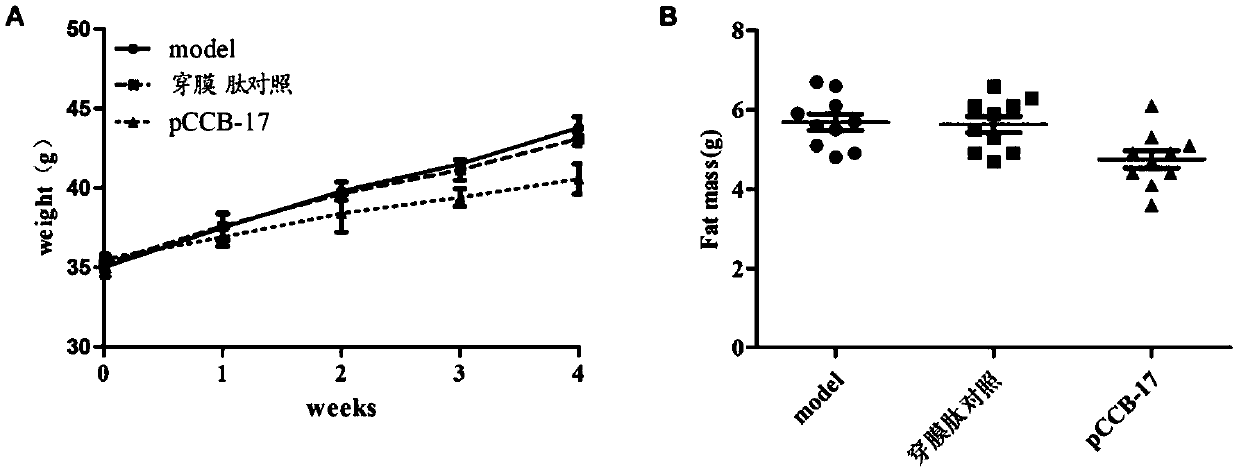Crtc2/Creb compound blocking polypeptide and derivative medicinal polypeptide and application thereof
A compound and drug technology, which is applied to Crtc2/Creb complex blocking polypeptide and its derivative drug polypeptide and application fields, can solve the problems affecting the quality of life and longevity of patients, and achieve the goal of regulating blood sugar, regulating hepatic glucose and lipid metabolism, and achieving high-efficiency The effect of transmembrane efficiency
- Summary
- Abstract
- Description
- Claims
- Application Information
AI Technical Summary
Problems solved by technology
Method used
Image
Examples
Embodiment 1
[0022] Example 1: Design and Synthesis of Polypeptide Molecules
[0023] Analyze the existing protein structure information of CRTC2 and CREB through bioinformatics, use the computer molecular docking software to analyze the binding domain and key amino acid residues of CRTC2-CREB, and then use the polypeptide-protein molecular docking software to analyze and design a high-affinity binding RBBp4 Protein and block the polypeptide molecule of SALL4-RBBp4 interaction, through screening to obtain the polypeptide that specifically targets and inhibits the formation of Crtc2 / Creb complex, the amino acid sequence is shown in SEQ ID NO: 1, hereinafter referred to as CCB-17.
[0024] Screening a membrane-penetrating peptide, the amino acid sequence of which is shown in SEQ ID NO:2, is used to guide the above-mentioned CCB-17 to efficiently enter the cytoplasm and nucleus. Design a drug polypeptide, hereinafter referred to as pCCB-17, including the penetrating peptide sequence and the C...
Embodiment 2
[0026] Example 2: Polypeptide membrane penetration and cell localization detection
[0027] 1. Resuscitate and culture LO2 cells.
[0028] 2. Inoculate the cells into a 96-well plate according to the appropriate number of cells, and inoculate three replicate wells for each cell strain.
[0029] 3. After 6 hours of cell inoculation, add the test polypeptide with a final concentration of 30uM.
[0030] 4. Record the FITC fluorescence of the cells after 24 hours of polypeptide treatment, and evaluate the membrane penetration efficiency and intracellular localization of the polypeptide.
[0031] The test results show that the drug polypeptide pCCB-17 can efficiently penetrate the cell membrane, and is located in the cytoplasm and nucleus in the cell. The test results are as follows: figure 1 shown.
Embodiment 3
[0032] Example 3: Co-immunoprecipitation detection of the blocking of the Crtc2 / Creb complex by the drug polypeptide pCCB-17
[0033] 1. Resuscitate and culture LO2 cells.
[0034] 2. Treat LO2 cells with a final concentration of 30uM membrane-penetrating peptide and drug polypeptide pCCB-17 for 24 hours, remove the medium, wash twice with PBS, centrifuge at 1000rpm for 5 minutes, and collect the cells.
[0035] 3. Suspend the cells in RIPA buffer, incubate on ice for 30 minutes, and lyse the cells with a sonicator (30s on, 30s off, 5 cycles).
[0036] 4. The lysate was centrifuged at 13,000 rpm for 10 min, and the supernatant was collected for protein quantification.
[0037] 5. Take the lysate of 1mg of total protein and incubate with 3ug CRTC2 antibody (abcam # ab109081) at 4°C and shake overnight.
[0038] 6. Add 50ul Protein A (Dynabeads®) to incubate for 1 hour, and wash the magnetic beads 6 times with IP buffer.
[0039] 7. Elute with 2X SDS buffer and incubate the p...
PUM
 Login to View More
Login to View More Abstract
Description
Claims
Application Information
 Login to View More
Login to View More - R&D
- Intellectual Property
- Life Sciences
- Materials
- Tech Scout
- Unparalleled Data Quality
- Higher Quality Content
- 60% Fewer Hallucinations
Browse by: Latest US Patents, China's latest patents, Technical Efficacy Thesaurus, Application Domain, Technology Topic, Popular Technical Reports.
© 2025 PatSnap. All rights reserved.Legal|Privacy policy|Modern Slavery Act Transparency Statement|Sitemap|About US| Contact US: help@patsnap.com



